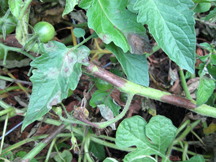Late blight disease found on Indiana tomato samples
August 21, 2013
 |
|
The leaves of tomato plants with late blight show brownish spots. (Purdue Department of Botany and Plant Pathology photo/Janna Beckerman) |
WEST LAFAYETTE, Ind. - Late blight was confirmed this week on several tomato samples from Tippecanoe County in west-central Indiana, leading the Purdue University Plant and Pest Diagnostic Laboratory to urge growers to inspect their plants for the destructive disease.
Symptoms of late blight, caused by the fungal-like organism Phytophthora infestans, include olive green to brown spots on leaves with slightly fuzzy-white fungal growth on the underside when conditions have been humid, such as in the early morning or after rain. The lesion border sometimes is yellow or has a water-soaked appearance. Brown to blackish lesions also develop on upper stems, and brown spots develop on tomato fruit.
The disease can spread quickly in tomato and potato plantings in cool and wet conditions. Its spread is slowed by hot, sunny weather.
"All growers should assume their crops may eventually be affected and thus should be on a weekly schedule to both thoroughly inspect their potato and tomato plantings and apply fungicides if the weather remains cool and cloudy," Tom Creswell, PPDL director, and senior plant disease diagnostician Gail Ruhl advised on the PPDL's website.
They said infected plants in home gardens should be removed immediately and either burned or put in a plastic bag for disposal.
 |
|
The upper stems of tomato plants infected with late blight develop dark lesions. (Purdue Department of Botany and Plant Pathology photo/Janna Beckerman) |
"Do not compost affected plants, as spores will spread from this infected debris to other healthy tomato plants," they said.
Because there are many similar diseases on tomato leaves, identification of late blight requires examination by microscope, they said. Samples can be submitted for analysis to Plant and Pest Diagnostic Laboratory, LSPS-Room 101, Purdue University, 915 W. State St., West Lafayette, IN 47907-2054.
More information on late blight is available in the Purdue Extension publication Late Blight on Tomato and Potato at http://www.extension.purdue.edu/extmedia/BP/BP-80-W.pdf.
Commercial growers can benefit from Purdue Extension's publication Midwest Vegetable Production Guide for Commercial Growers 2013, which includes disease control measures. It is available through The Education Store at https://mdc.itap.purdue.edu/item.asp?Item_Number=ID-56.
Writer: Keith Robinson, 765-494-2722, robins89@purdue.edu
Sources: Tom Creswell, 765-494-8081, creswell@purdue.edu
Dan Egel, Purdue Extension plant pathologist, 812-886-0198, egel@purdue.edu
Ag Communications: (765) 494-2722;
Keith Robinson, robins89@purdue.edu
Agriculture News Page

